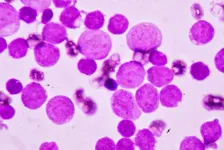(Press-News.org) ITHACA, NY - Biologists have long wondered how complex organisms contain a variety of dramatically different types of cells with specialized functions, even though all of those cells are genetically identical.
New research reveals how proteins, called "pioneer transcription factors," help turn on key genes that give cell types their unique properties and functions.
These pioneer factors, it turns out, help unspool tightly wound coils of DNA so that genetic blueprints in genes can be read and proteins that play roles in biological processes can be made.
The study in fruit flies, "Pioneer-like Factor GAF Cooperates with PBAP (SWI/SNF) and NURF (ISWI) to Regulate Transcription," was published Dec. 10 in the journal Genes & Development.
"We know pretty well what pioneer factors are and what they do, but what we don't know is how they work exactly," said first author Julius Judd, a graduate student in the lab of senior author John Lis, professor of molecular biology and genetics in the College of Agriculture and Life Sciences.
In a cell's nucleus, DNA is bound around a collection of histone proteins called nucleosomes. "DNA is wrapped around it and so the backside of the DNA is inaccessible to recognition because it's up against these proteins," Lis said.
As a result, the transcription factors and machinery required to read DNA sequences for making proteins can't access these genetic codes. Genes therefore exist in a default "off" state until the DNA can be accessed and the codes can be read.
In the study, the researchers focused on a suspected pioneer transcription factor found in fruit flies called GAGA-factor (GAF). Previous work in Lis' lab has shown that GAF binds to target genes and removes nucleosomes; that exposes DNA sequences that mark where transcription of a gene begins, called a promoter sequence.
Research in other labs also suggested that GAF plays a role in embryonic development. And the researchers had evidence that GAF interacts with two different complexes called remodelers, which catalyze the process of removing the nucleosomes from DNA. All of this evidence led Lis, Judd and colleagues to believe that GAF was indeed a pioneer factor.
To test their hypothesis, Judd ran a number of different genome-wide assays to monitor transcription; how accessible the chromatin (spooled DNA) is for transcription; where GAF binds; and the cellular levels of RNA that are translated into protein. They applied these assays both to untreated Drosophila cells and cells where GAF was depleted.
The studies revealed that when GAF binds to a target gene, it recruits a remodeler called PBAP, which removes these nucleosomes and creates an accessible tract of DNA for transcription. Furthermore, at some genes nucleosomes immediately downstream of the promoter also need to be moved. In those cases, GAF relies on a different remodeler, called NURF, to push the first nucleosome along the gene out of the way to make it easier for the transcription machinery to transcribe the DNA.
"We found one pioneer factor that can interact with both remodelers and act at different steps in the process of transcription. That is what is particularly novel," Lis said.
Prior evidence has identified remodeling complexes almost identical to PBAP and NURF in yeast, and there are suggestions that this process occurs in mice and possibly mammals. "We think the way these remodelers are working is a deeply conserved and the conclusions are broadly applicable," Judd said.
INFORMATION:
Fabiana Duarte, Ph.D. '16, a postdoctoral researcher at Harvard, is a co-author of the study.
The study was funded by the National Institutes of Health.
January 22, 2021 - Patients with substance use disorders (SUDs) being treated for serious medical conditions are more likely to leave the hospital against medical advice (AMA) than those without addiction. A special type of contract with healthcare providers might enable patients to consent in advance to life-saving medical care - even if they later refuse treatment, according to a commentary in the Journal of Addiction Medicine, the official journal of the American Society of Addiction Medicine (ASAM). The journal is published in the Lippincott portfolio by Wolters Kluwer.
The Substance Use Advance Directive (SUAD) "has the potential to greatly improve the current state of treatment for life-threatening comorbid conditions in SUD patients through ...
Human activities might have shifted the movement of caribou in and near the Arctic National Wildlife Refuge, according to scientists with the University of Cincinnati.
Each year caribou take on one of nature's longest land migrations, trekking hundreds of miles across Alaska and Canada to find food and give birth in their preferred calving grounds.
A UC study published today in the journal Frontiers in Ecology and Evolution identified a shift in one herd's movements after the 1970s that coincided with changes in herd size and climate, and the construction of new roads and other energy infrastructure.
Researchers used isotope analysis of antlers shed by female caribou to track their historical patterns of movement over the landscape. Female caribou are unique among deer for growing ...
COLUMBUS, Ohio - A new study suggests that a lot of people might be going through life with symptoms that resemble concussion - a finding supporting researchers' argument that athletes recovering from a brain injury should be assessed and treated on a highly individualized basis.
In the national study, between 11% and 27% of healthy college athletes with no history of a recent concussion reported combinations of symptoms that met criteria for post-concussion syndrome (PCS) as defined by an international classification system. Among the nearly 31,000 student-athletes surveyed, three factors stood out as the most likely to predict ...
Alongside Dennis vanEngelsdorp, associate professor at the University of Maryland (UMD) in Entomology named for the fifth year in a row for his work in honey bee and pollinator health, Yiping Qi, associate professor in Plant Science, represented the College of Agriculture & Natural Resources on the Web of Science 2020 list of Highly Cited Researchers for the first time. This list includes influential scientists based on the impact of their academic publications over the course of the year. In addition to this honor, Qi is already making waves in 2021 with a new high-profile publication in Nature Plants introducing SpRY, a newly engineered variant ...
Researchers at the Paul Scherrer Institute PSI have put forward a detailed plan of how faster and better defined quantum bits - qubits - can be created. The central elements are magnetic atoms from the class of so-called rare-earth metals, which would be selectively implanted into the crystal lattice of a material. Each of these atoms represents one qubit. The researchers have demonstrated how these qubits can be activated, entangled, used as memory bits, and read out. They have now published their design concept and supporting calculations in the journal PRX Quantum.
On the way to quantum computers, an initial requirement is to create so-called quantum ...
In June 1991, Mount Pinatubo, a volcanic peak on the Philippine Island of Luzon, literally blew its top. It was the second-most powerful volcanic eruption of the 20th century, ten times stronger than Mount Saint Helens, and its effects were devastating. Lava and ash spewed into the surrounding environment in the Zambales Mountains, pooling in layers up to 600 feet thick in the valleys. Following the eruption, powerful typhoons and monsoon rains triggered landslides and ash flows that continued for many months. Eight hundred people lost their lives, and the lush forests that covered the mountain prior to the eruption were destroyed or severely damaged. In recent years, scientists returned to the region to survey the surviving mammal populations, and in a new paper in the ...
Human papillomavirus (HPV) is the most common sexually transmitted infection, with an estimated 79 million Americans currently infected with the virus, according to the Centers for Disease Control and Prevention. If a high-risk HPV infection does not go away, it can lead to the development of a variety of cancers, including 91% of all cervical cancers, 70% of oropharyngeal cancers and cancers of the vulva, vagina, penis and anus.
HPV vaccination can significantly reduce the number of new cancer diagnoses linked to the virus, in addition to preventing a number of other health complications.
"Given ...
Patients with acute myeloid leukemia (AML), the most common form of acute leukemia in adults, that has gone into remission following initial chemotherapy remain in remission longer and have improved overall survival when they are given a pill form of the cancer drug azacitidine as a maintenance treatment, according to a randomized, international phase 3 clinical trial for which Weill Cornell Medicine and NewYork-Presbyterian are trial sites. This is the first time a maintenance treatment for AML has shown such a strong benefit for patients, and it is already being adopted as part of standard care.
The results, which were published Dec. 24 in the New England Journal of Medicine, led to the U.S. Food and Drug Administration's approval in September 2020 of oral ...
Many college students fully recover from infectious mononucleosis (which is almost always caused by Epstein-Barr virus) within 1-6 weeks, but some go on to develop chronic fatigue syndrome, also called myalgic encephalomyelitis (ME/CFS). A longitudinal study from DePaul University and Northwestern University followed 4,501 college students to examine risk factors that may trigger longer illness. The research appears in the journal Clinical Infectious Diseases and was funded by the National Institute of Allergy and Infectious Diseases.
Previous retrospective studies found that risk factors ...
By 2050, most people on Earth will live downstream of tens of thousands of large dams built in the 20th century, many of them already operating at or beyond their design life, according to a UN University analysis.
The report, "Ageing water infrastructure: An emerging global risk," by UNU's Canadian-based Institute for Water, Environment and Health, says most of the 58,700 large dams worldwide were constructed between 1930 and 1970 with a design life of 50 to 100 years, adding that at 50 years a large concrete dam "would most probably begin to express signs of aging."
Ageing ...




